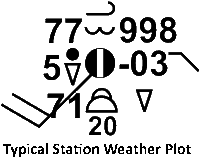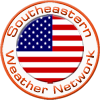Why Map Analysis |
Analyzing maps with the current weather conditions is an essential part of the entire forecast process. Basically, if we do not know what is
currently occurring, it is near impossible to predict what will happen in the future.
Computers have been able to analyze maps for over 20 years. However, computers cannot interpret what they analyze. There is no substitute for the hand analysis. Analyzing maps by hand causes the forecaster to study every detail in the weather and enables him/her to discern the continuity or "flow" of the weather.
Great forecasts, the ones that save lives and property, begin with the careful analysis of the current conditions. Conversely, based upon post-analysis, "bad" (or busted) forecasts, the ones most remembered by the public, could have been improved if one did a careful analysis in the beginning.
Map analysis is not too unlike drawing in a dot-to-dot coloring book. Just as one would draw a line from one dot to the next, analyzing maps is similar in that we will draw lines of equal values between dots representing various elements of the atmosphere.
Computers have been able to analyze maps for over 20 years. However, computers cannot interpret what they analyze. There is no substitute for the hand analysis. Analyzing maps by hand causes the forecaster to study every detail in the weather and enables him/her to discern the continuity or "flow" of the weather.
Great forecasts, the ones that save lives and property, begin with the careful analysis of the current conditions. Conversely, based upon post-analysis, "bad" (or busted) forecasts, the ones most remembered by the public, could have been improved if one did a careful analysis in the beginning.
Map analysis is not too unlike drawing in a dot-to-dot coloring book. Just as one would draw a line from one dot to the next, analyzing maps is similar in that we will draw lines of equal values between dots representing various elements of the atmosphere.
How to Read 'Surface' Weather Maps |
 On surface maps you will
often see station weather plots. Since meteorologists must convey a lot of information without using a lot of words, plots are used to describe
the weather at a station for a specific time. When all stations are plotted on a map, a "picture" of where the high and low pressure
areas are located, as well as the location of fronts, can be obtained.
On surface maps you will
often see station weather plots. Since meteorologists must convey a lot of information without using a lot of words, plots are used to describe
the weather at a station for a specific time. When all stations are plotted on a map, a "picture" of where the high and low pressure
areas are located, as well as the location of fronts, can be obtained.There are a large number of weather symbols used for station plotting. Some are used for weather elements such as rain, snow, and lightning. Others represent the speed of the wind, types of clouds, air temperature, and air pressure. All of these symbols help meteorologists depict the weather occurring at a weather observing station.
This sample plot represents the maximum amount of information about the current weather at an observing station. Hand plotted maps usually contain the full weather information. However, most computer generated surface weather maps omit some data such as clouds types and heights.
Before computers, the plotting of weather maps was considered an art. In fact, Aerographers (weathermen) in the U.S. Navy continue to plots maps by hand. A skilled plotter can easily fit the above information under the space covered by a dime.
Decoding these plots is easier than it may seem. The values are located in a form similar to a tic-tac-toe pattern.
 |
In the upper left, the temperature is plotted in Fahrenheit. In this example, the temperature is 77°F. |
 |
Along the center, the cloud types are indicated. These cloud types use the same cloud codes as found in the cloud section of the Weather Symbols page. The top symbol is the high-level cloud type followed by the mid-level cloud type. The lowest symbol represents low-level cloud over a number which tells the height of the base of that cloud (in hundreds of feet) In this example, the high level cloud is Cirrus, the mid-level cloud is Altocumulus and the low-level clouds is a cumulonimbus with a base height of 2000 feet. [more on these symbols] |
 |
At the upper right is the atmospheric pressure reduced to mean sea level in millibars (mb) to the nearest tenth with the leading 9 or 10 omitted. In this case the pressure would be 999.8 mb. If the pressure was plotted as 024 it would be 1002.4 mb. When trying to determine whether to add a 9 or 10 use the number that will give you a value closest to 1000 mb. |
 |
On the second row, the far left number is the visibility in miles. In this example, the visibility is 5 miles. |
 |
Next to the visibility is the present weather symbol. There 95 symbols which represent the weather that is either presently occurring or has ended within the previous hour. In this example, a light rain shower was occurring at the time of the observation. [See all the symbols] |
 |
The circle symbol in the center represents the amount of total cloud cover reported in eighths. This cloud cover includes all low, middle, and high level clouds. In this example, 7/8th of the sky was covered with clouds. [see the complete list of symbols] |
 |
This number and symbol tell how much the pressure has changed (in tenths of millibars) in the past three hours and the trend in the change of the pressure during that same period. In this example, the pressure was steady then fell (lowered) becoming 0.3 millibars LOWER than it was three hours ago. [see all pressure tendency symbols] |
 |
These lines indicate wind direction and speed rounded to the nearest 5 knots. The longest line, extending from the sky cover plot, points in the direction that the wind is blowing FROM. Thus, in this case, the wind is blowing FROM the southwest. The shorter lines, called barbs, indicate the wind speed in knots (kt). The speed of the wind is determined by the barbs. Each long barb represents 10 knots with short barbs representing 5 knots. In this example, the station plot contains two long barbs so the wind speed is 20 knots, or about 24 mph. [more about wind barbs] |
 |
The 71 at the lower left is the dewpoint temperature. The dewpoint temperature is the temperature the air would have to cool to become saturated, or in other words reach a relative humidity of 100%. |
 |
The lower right area is reserved for the past weather, which is the most significant weather that has occurred within the past six hours excluding the most recent hour. [see the complete past weather symbols] |
Analyzing Weather Maps |
Once you can read a station plot you can begin to perform map analyses. Meteorologists use the station plots to draw lines of constant pressure (isobars), temperature (isotherms), and dewpoint (isodrosotherms) to achieve an understanding of the current state of the atmosphere. This knowledge ultimately leads to better weather forecasts and warnings.










